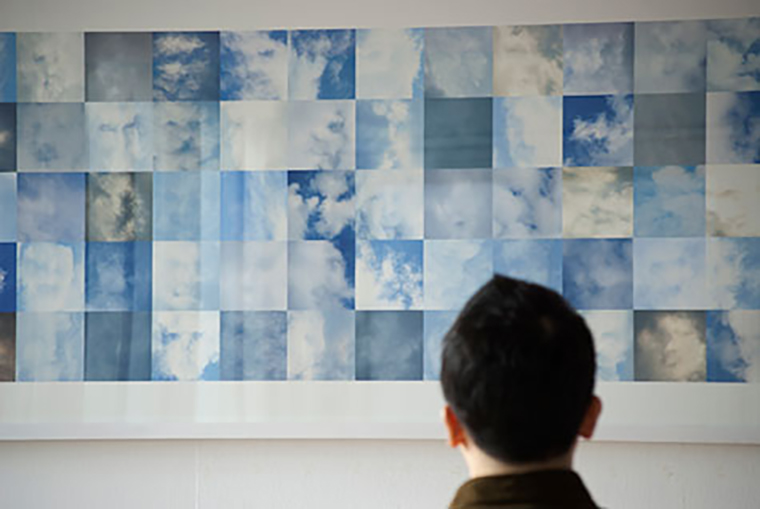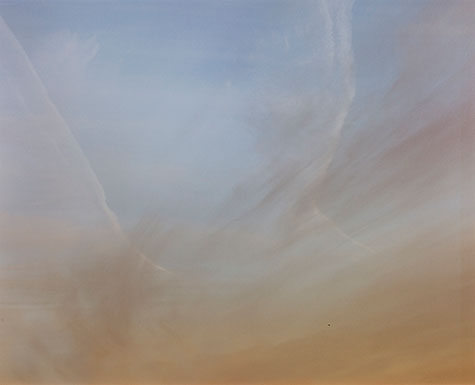
We are living at the dawn of the drone age. Over the last decade, the United States and other countries have increasingly outsourced military operations to unmanned aerial vehicles (UAVs), colloquially known as drones. Today, the U.S. Air Force trains more drone operators than fighter and bomber pilots combined — and hopes to double that number in the next five years.
Yet drones embody a series of contradictions. They are ubiquitous and invisible, all-seeing but susceptible to errors of judgment and interpretation.
In the artwork “Cloud Face” (2012), the artist collective Shinseungback Kimyonghun (a.k.a. Shin Seung Back and Kim Yong Hun) slyly critiques the shortcomings of drone vision. The piece collects dozens of cloud formations that facial recognition algorithms have mistakenly identified as human. The effect is at once humorous and chilling. Gazing upward, people see faces where they do not exist. So too, it emerges, does software.
This January, the Mildred Lane Kemper Art Museum at Washington University in St. Louis will present “Cloud Face” as part of “To See Without Being Seen: Contemporary Art and Drone Warfare.” Featuring work by an international array of artists, the exhibition includes 17 projects in a variety of media that together investigate the geopolitical ramifications of drone warfare while raising timely questions about power, agency, visibility, technology, surveillance and fear.
The exhibition follows a series of significant projects mounted at the Museum over the past decade that present new ways of understanding our contemporary world through engagement with artistic responses to war, political strife and trauma.

The opening section, “Bringing the War Home,” explores how drones blur distinctions between civilian and military — and turns the drone’s gaze, typically deployed abroad, back to the domestic sphere. Trevor Paglen’s “Untitled (Reaper Drone)” (2010) captures an image of a UAV, so small that it’s barely visible, crossing the luminous sky above Nevada’s Nellis Range Complex. The Center for Land Use Interpretation employs Google Maps to create a database of “Notable Drone-Related Sites in the USA” (2015), pinpointing locations at which drones are developed, tested and launched. James Bridle’s unsettling “Drone Shadow” (2016) underscores both the physical reality and apparent invisibility of drones. Part of a series of site-specific installations, the piece consists of a drone outline, drawn at full scale, on the sidewalk by the Museum’s north entrance.
The second section, “Tracking and Targeting,” focuses on human-machine interactions and the influence of mechanized vision on perception, thought and action. The filmmaker Harun Farocki is represented by the prescient two-channel installation “Eye/Machine III” (2003), which examines the emergence of “operative images,” that is, images created for technical rather than aesthetic purposes. Paglen’s “Drone Vision” (2010) affords the public a rare glimpse of actual video footage intercepted from a drone camera. “Unmanned” (2012), a video game by Molleindustria, goes a step further, inviting visitors to assume the role of a drone pilot who wages war during the day and at night returns home to family.
The third and final section, “Countersurveillance,” addresses the politics of privacy and the mechanics of obfuscation. In addition to “Cloud Face,” works include selections from Adam Harvey’s “CV Dazzle” (2013), which details makeup and hairstyling strategies designed to thwart facial recognition software. Hito Steyerl’s video installation “HOW NOT TO BE SEEN: A F***ing Didactic Educational .MOV File” (2013) offers barbed tips for avoiding drone strikes. Suggestions range from “being fitted with an invisibility cloak” to “being a superhero” and “being female and over 50.”
“Pretend you are not there,” the narrator dryly intones. “Become smaller or equal to one pixel.”
